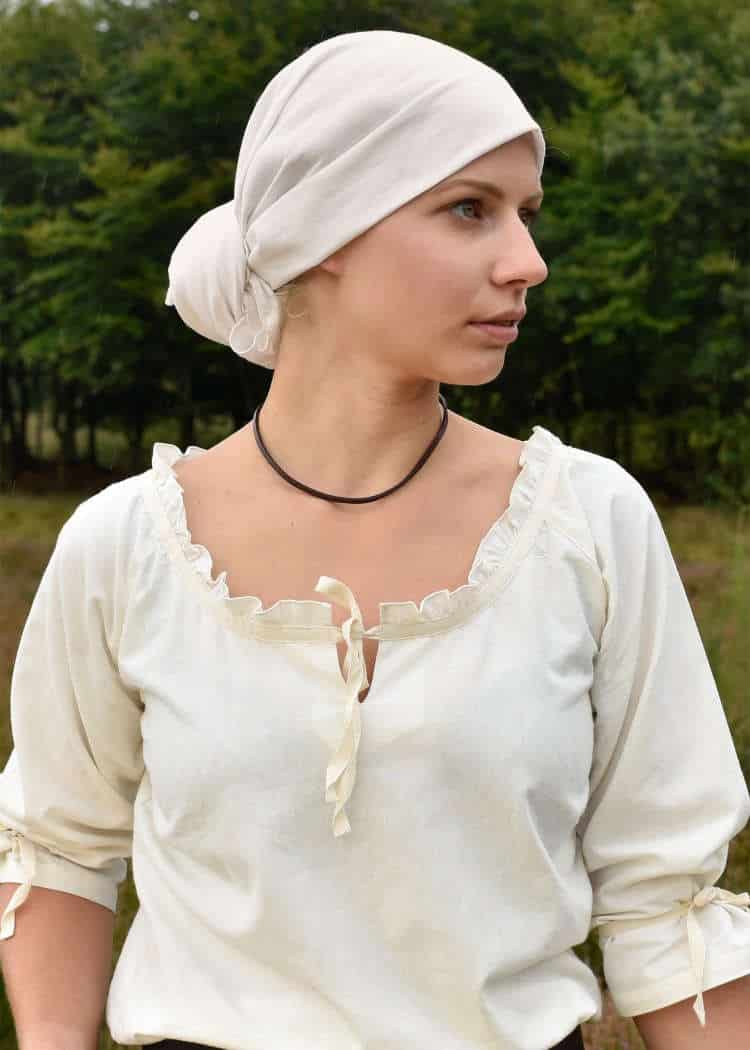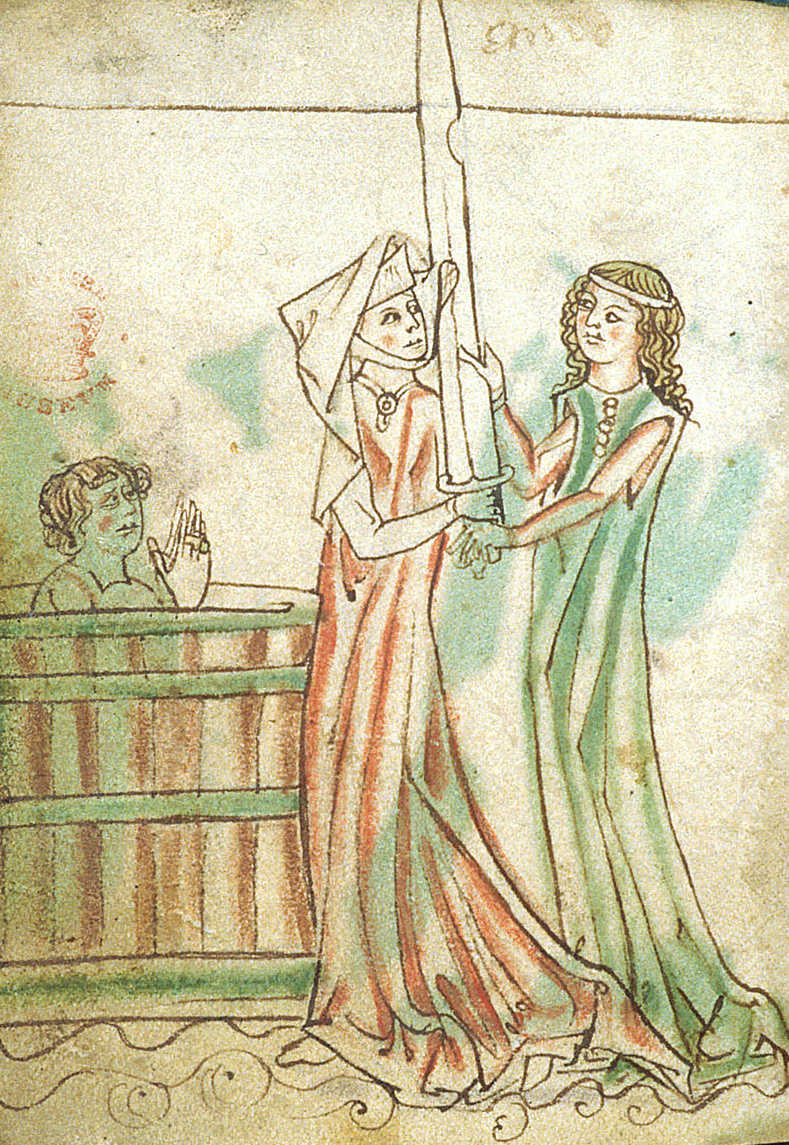The wimple, also spelled whimple, was a very common head covering for women of the Middle Ages (c. 500—c. 1500). Popular from the twelfth through the fifteenth centuries, wimples were light veils, usually made of linen or silk, which were fastened all the way around the neck, up to the chin. Sometimes the bottom edge of the wimple was tucked into the collar of the dress. The wimple provided both protection from the weather and modesty. A wimple was often worn with a veil called a couvrechef, which covered the top of the head and flowed down over the shoulders.
Wimple is the name of the covering worn over the head and around the neck and chin by women in the late medieval period, as well as by some modern nuns. Its name is akin to Old Saxon 'wimpal' and Middle Dutch 'wimpel,' both of which mean 'veil' or 'banner.' This rectangular piece of cloth is made of plain cotton fabric and features rolled hems. It can be tied as a so-called wimple or as a headscarf for medieval reenactment, but is also versatile in modern everyday life. It can be worn as a stylish hair band, a turban, a shawl draped over the shoulders or a scarf elegantly wrapped around the neck. In Italy, the fashion was to wear a translucent wimple to show off the elaborate braids underneath. All of this was condemned by the Church as vanity, but did not stop the parade of fashion. Because such emphasis was put on covering the hair, the medieval ideal was of a high, round forehead.
In the Europe of the Middle Ages, it was customary for married women to cover their hair as a sign of modesty. The wimple and veil combination was an excellent headdress for demonstrating modest respectability, since it covered everything except a
- A medieval woman wearing a wimple. Wimples offer both protection from the weather and modesty and a form of them is still worn by some nuns. Reproduced by permission of © Sandro Vannini/CORBIS.
woman's face. However, wealthy women sometimes used the wimple to display their riches as well, by attaching jewels to the cloth before placing it on their heads. Sometimes a circle of fabric or metal was placed on the head like a crown to hold the wimple in place.

The modesty and plainness of the wimple made it a popular choice for nuns, female members of Catholic religious orders. Nuns choose lives of religious service and usually live and dress simply. During the Middle Ages many nuns adopted the wimple as part of their uniform dress, and many nuns continue to wear the wimple in the twenty-first century.
FOR MORE INFORMATION
Dawson, Imogen. Clothes and Crafts in the Middle Ages. Milwaukee, WI: Gareth Stevens, 2000.
MacDonald, Fiona. Women in Medieval Times. Columbus, OH: Peter Bedrick Books, 2000.

Was this article helpful?
Medieval Wimple And Veil Num
An interesting question surfaced yesterday, what was the first hat you ever made? It is no suprise that the answer seemed to generate a great deal of sniggering since not many people know that the term ‘wimple’ refers to a medieval headress (not as some of my more wagish friends surmised a pimple on a women’s head sported mainly by nuns… that was the least offensive suggestion offered). When I was at art college (and yes that was before anyone used computers), I did a number of assignments involving theatrical costume design. As the visiting lecturer was in fact the wadrobe mistress with the Royal Opera House, these projects leaned towards historical period pieces with a heavy Italian influence. So with great confidence I launched into producing my first hat, a rather grand double horned wimple in the style of the medieval Italian Court. Bearing in mind that I had no prior experience and my starting point was a poorly reproduced book reference as seen below, I had no idea how to tackle this project.
The tutor suggested that I should first produce my own felt to block into a cap so after raiding the textile departments stash of fleece, I laboriously produced a half yard square of felt which I then dyed what I thought was a majestic green. I then blocked the felt to form a sturdy caplet base for my creation. The next step was I thought a bit off piste, as I fashioned the horns from chicken wire. It turns out that this was in fact pretty close to the way in which these projectiles were orignally created using either wicker basketry or metal wire cage structures to generate height without increasing weight. I covered the chicken wire in linen soaked in size (natural animal based fabric stiffener), before dying some old cotton velvet curtains which I cut into strips before winding around the horns. I then covered the seams with lace crocheted from a gold spun thread and draped the finished hat with a silk scarf (which I also dyed pale eau de nil. My poor sister (which is where this conversation started) then kindly offered to model this beomoth for my portfolio, gamely balancing the whole contraption on her tiny frame. Unfortunately the original photo has long since been lost but here is a close approximation of the finished article.

What’s a wimple?
So for those of you who have expressed an interest, here is the real answer to the question, ‘What is a wimple?’ A wimple is an ancient form of female headdress, composed of a large piece of cloth worn around the neck and chin, and covering the top of the head. This cloth was often supported with elaborate constructions designed to add height and importance to demonstrate status. Its use developed in early medieval Europe. At many stages of medieval Christian culture it was unseemly for a married woman to show her hair. A wimple might be elaborately starched, and creased and folded in prescribed ways, and later elaborated versions were supported on wire or wicker framing, such as the cornette.

Contemporary Wimples
Italian women abandoned their head cloths in the 15th century, or replaced them with transparent gauze, and showed their elaborate braids. Both elaborate braiding and elaborately laundered clothes demonstrated status, in that such grooming was being performed by others. Today the wimple is worn by certain nuns who retain a traditional habit.
Medieval Wimple And Veil
The wimple has flirted with fashion revivals briefly in the 1930’s and 1950’s with scarfed headgear made popular by screen sirens like Lauren Bacall and then later Grace Kelly and Jackie Onassis. Modern designers still sometimes incorporate scarves into their designs to appeal to customers who like to be served a large portion of modesty with their haut couture. Similarly some of the Middle Eastern airlines incorporate a wimple concept into their uniforms. Maybe I will try some experiments blending my collection of vintage designer silk scares from Hermes, Gucci and Versace with the humble pill box. Could produce some interesting results.
In literature
Medieval Wimple Hat
The Wife of Bath and the Prioressare depicted wearing wimples in the Canterbury Tales of Geoffrey Chaucer (c.1343-1400).
Medieval Wimple And Veil
The King James Version of the Bible explicitly lists wimples in Isaiah 3:22 as one of a list of female fineries, however the Hebrew word “miṭpaḥoth” (מִטְפָּחוֹת) means kerchief.